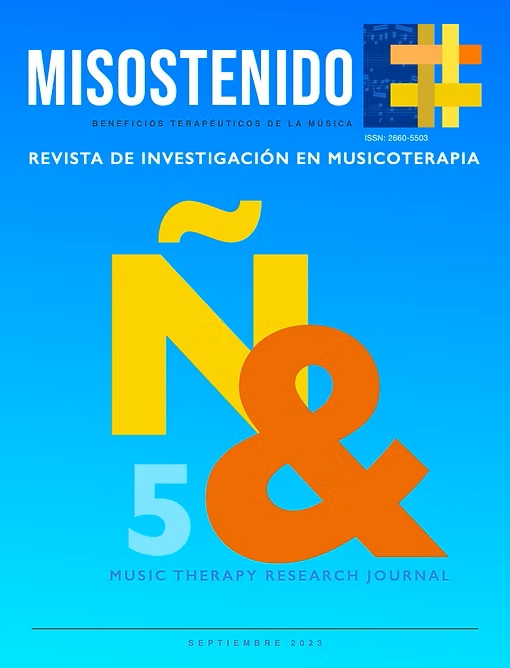Group Music therapy with students between 10 and 12 years old to improve self-esteem through the bruscia method.
DOI:
https://doi.org/10.59028/misostenido.2023.15Keywords:
Music Therapy, self-esteem, Bruscia method, listening and emotionsAbstract
In the Master's thesis, during the 2021-2022 academic year, an intervention was carried out, in a public educational center, for children in 5th grade, to improve their self-esteem and non-verbal communica- tion of the group and thus increase their confidence through music therapy due to the emotional defi- ciencies that were observed in them.The results were positive since there was an improvement in the self-esteem of the group, which was reflected in the results of the Rosenberg Self-Esteem Scale and the academic results.The method that was carried out was Bruscia since the group was physically acti- ve with a need to be heard and express their emotions. In conclusion, the application of preventive music therapy in the group has benefited the attention to the educational needs of the students by offering them a space to express their emotions and make their observations of what they thought and felt in coherence with the action of the movement. The fact that it is a dynamic and active interven- tion has produced an improvement in care. In addition, body and emotional control have evolved along with expression, personal initiative, and creativity, aspects that have helped them in their academic per-formance.
Downloads
References
Blasco Magraner, J. S., & Bernabé Valero, G. (2016). La musicoterapia en el contexto escolar: estudio de un caso con tras- torno del espectro autista.
Bruscia, Kenneth. E. (2007) Musicoterapia. Métodos y prácticas. Pax México. Páginas 18-27 y 97-108.
Ekman, P., & Friesen, W. V. (1972). Hand movements. Journal of communication, 22(4), 353-374. https://doi.org/10.1111/j.1460-2466.1972.tb00163.x
Formariz, M.N. (2019). Propuesta de intervención, a través de técnicas de intervención en Musicoterapia para favorecer la autoestima en contextos educativos en riesgo de exclusión social. Revista de investigación en Musicoterapia 3. https://doi.org/10.15366/rim2019.3.004
Gadberry, A. (2011) Steady beat and State anxiety. Journal of Music Therapy 48(3): 346-356. https://doi.org/10.1093/jmt/48.3.346
González-Claros, O. (2022). Musicoterapia y relaciones sociales en educación infantil: propuesta de intervención. Revista Misostenido, 3, 63-70.
Goldbeck, L. & Ellerkamp, T. (2012) A Randomized Controlled Trial of Multimodal Music Therapy for Children with Anxiety Disorders. Journal of Music Therapy, 49(4): 395-413. https://doi.org/10.1093/jmt/49.4.395
Hart, R. (1993). La participación de los niños. De la participación simbólica a la participación auténtica. Ensayos Innocenti, (4).
Mercadal-Brotons, y P. Martí Augé. (Ed.), Música, musicoterapia y discapacidad (pp. 161-171). Ed. Médica Jims, S.L
Naranjo, M.L. (2007). Autoestima: un factor relevante en la vida de la persona y tema esencial del proceso educativo. Actualidades investigativas en Educación, 7(3), 1-27. https://doi.org/10.15517/aie.v7i3.9296
Olmo-Barros, Salinas-Ramos y Pérez-Eizaguirre. (2015). Musicoterapia en el aula: estudio sobre su uso en Educación Secundaria Obligatoria. Pulso, 38, 107-128. https://doi.org/10.58265/pulso.5075
Ortegón, L.A. (2021). La musicoterapia en el fortalecimiento de la autoestima en un grupo de adolescentes del IED Rafael Bernal Giménez dde Bogotá. [Maestría en musicoterapia, Universidad Nacional de Colombia]. https://doi.org/10.5965/2358092514142015117
Overy, K. y Molnar-Szakacs, I. (2009). Being together in time: musical experience and the mirror neuron system. Journal Music Percept, en Chávez, S., y Barrena, F. (2012). Romper el silencio: musicoterapia aplicada al TEA . https://doi.org/10.1525/mp.2009.26.5.489
Pérez Ezaguirre, M (2018). Efectos de la Musicoterapia en las relaciones sociales de grupos de adolescentes en un centro educativo. Revista Electrónica Complutense de Investigación en Educación Musical, 15, 175-191. https://doi.org/10.5209/reciem.53627
Salvador, M y Martínez D. (2013). Grupo de musicoterapia en un centro de día para personas con trastorno mental grave. Rehabilitación Psicosocial, 10(1), 30-34
Whipple, J. (2012). Music therapy as an effective treatment for young children with autism spectrum disorders: a meta-analysis En P. Kern y M. Humpal (Eds.). Early childhood Music therapy and Autism Spectrum Disorders: Developing potential in young children and their families (pp. 58-76). Jessica Kingsley Publishers








